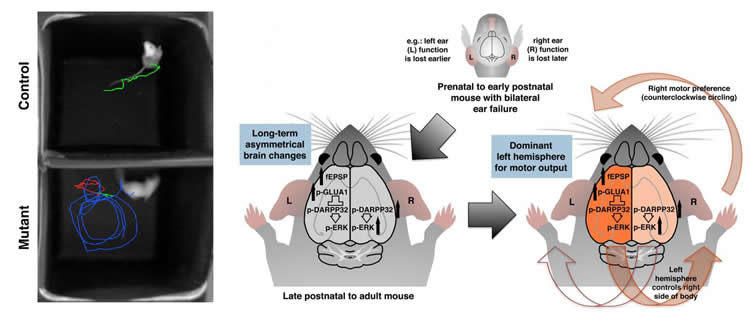Summary: A new study reveals differences in ear function can lead to asymmetrical brain differences in mice.
Source: PLOS.
Left-right differences in ear function have been found to lead to asymmetric brain development that affects the preferred direction of turning movement in mice. In a multi-national study publishing 13 March in the open access journal PLOS Biology, Michelle Antoine, Jean Hébert, and their colleagues at the Albert Einstein College of Medicine investigated the potential link between increased incidences of atypical asymmetries in motor behavior and defects in inner ear function.
Motor asymmetry is the preferential use of a limb or a body part on one side of the body, handedness or footedness being commonly known examples. Despite a long-standing fascination with asymmetries in left-right brain function by the public and scientific community alike, very little is known about the causes of functional brain asymmetry in mammals.
The authors used mice which have a genetic defect that affects the vestibular or balance-related function of their inner ear; these mice tend to “circle” repetitively, but their preferred direction of turning varies between individuals. Based on a series of genetic, surgical, and pharmacological experiments, researchers showed that even short-term imbalance of degenerating inner ear function in mice can lead to long-lasting asymmetries in the relative activity levels of two key neurotransmitters in the brain – glutamate and dopamine.
Asymmetry in these two neuronal signaling pathways correlated with the animal’s preferred spontaneous turning direction, such that the motor-dominant hemisphere had higher levels of glutamate neurotransmission and lower levels of dopamine signaling.
Furthermore, the authors could lessen or reverse the preferred turning direction by experimentally manipulating the levels of a specific signaling pathway (involving a protein called ERK) that integrates both glutamate and dopamine neurotransmission.

The authors also showed that their findings in mice could extend to humans with normal ear function. In experiments in which human subjects underwent brain imaging during stimulation to each ear, the ear with the weakest vestibular brain response correlated with the motor-dominant hemisphere, as measured by the participant’s handedness.
Functional brain asymmetry seems to arise independently of other anatomical asymmetries such as the positioning of the heart and liver, and no clear mechanism is known; by showing that early asymmetry in sensory input from the ear can permanently shape the asymmetric distribution of brain function, this study provides an important new insight.
Funding: German Federal Ministry of Education and Research (grant number 01 EO 0901). Received by Marianne Dieterich, Thomas Brandt. The funder had no role in study design, data collection and analysis, decision to publish, or preparation of the manuscript. NIH (grant number AG009524). Received by Robert D Frisina. The funder had no role in study design, data collection and analysis, decision to publish, or preparation of the manuscript. German Foundation for Neurology. Received by Marianne Dieterich. The funder had no role in study design, data collection and analysis, decision to publish, or preparation of the manuscript. Miller Institute for Basic Research in Science. Received by Michelle Antoine. The funder had no role in study design, data collection and analysis, decision to publish, or preparation of the manuscript. NIH (grant number MH083804). Received by Jean M Hébert. The funder had no role in study design, data collection and analysis, decision to publish, or preparation of the manuscript. Hertie-Foundation. Received by Thomas Brandt. The funder had no role in study design, data collection and analysis, decision to publish, or preparation of the manuscript. NIH (grant number HD090260). Received by Jean M Hébert. The funder had no role in study design, data collection and analysis, decision to publish, or preparation of the manuscript. NIH (grant number NS088943). Received by Jean M Hébert. The funder had no role in study design, data collection and analysis, decision to publish, or preparation of the manuscript.
Source: Jean Hébert – PLOS
Publisher: Organized by NeuroscienceNews.com.
Image Source: NeuroscienceNews.com image is credited to Antoine et al/PLOS Biology.
Original Research: Open access research in PLOS Biology.
doi:10.1371/journal.pbio.2002988
[cbtabs][cbtab title=”MLA”]PLOS “Lopsided Ear Function Can Lead to Lopsided Brain Development.” NeuroscienceNews. NeuroscienceNews, 13 March 2018.
<https://neurosciencenews.com/ear-brain-development-8627/>.[/cbtab][cbtab title=”APA”]PLOS (2018, March 13). Lopsided Ear Function Can Lead to Lopsided Brain Development. NeuroscienceNews. Retrieved March 13, 2018 from https://neurosciencenews.com/ear-brain-development-8627/[/cbtab][cbtab title=”Chicago”]PLOS “Lopsided Ear Function Can Lead to Lopsided Brain Development.” https://neurosciencenews.com/ear-brain-development-8627/ (accessed March 13, 2018).[/cbtab][/cbtabs]
Abstract
Early uneven ear input induces long-lasting differences in left–right motor function
How asymmetries in motor behavior become established normally or atypically in mammals remains unclear. An established model for motor asymmetry that is conserved across mammals can be obtained by experimentally inducing asymmetric striatal dopamine activity. However, the factors that can cause motor asymmetries in the absence of experimental manipulations to the brain remain unknown. Here, we show that mice with inner ear dysfunction display a robust left or right rotational preference, and this motor preference reflects an atypical asymmetry in cortico-striatal neurotransmission. By unilaterally targeting striatal activity with an antagonist of extracellular signal-regulated kinase (ERK), a downstream integrator of striatal neurotransmitter signaling, we can reverse or exaggerate rotational preference in these mice. By surgically biasing vestibular failure to one ear, we can dictate the direction of motor preference, illustrating the influence of uneven vestibular failure in establishing the outward asymmetries in motor preference. The inner ear–induced striatal asymmetries identified here intersect with non–ear-induced asymmetries previously linked to lateralized motor behavior across species and suggest that aspects of left–right brain function in mammals can be ontogenetically influenced by inner ear input. Consistent with inner ear input contributing to motor asymmetry, we also show that, in humans with normal ear function, the motor-dominant hemisphere, measured as handedness, is ipsilateral to the ear with weaker vestibular input.






